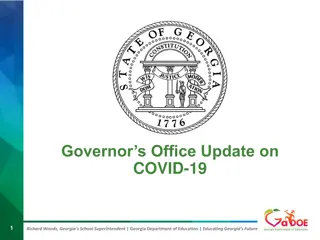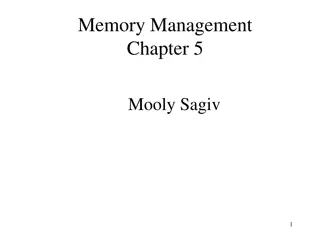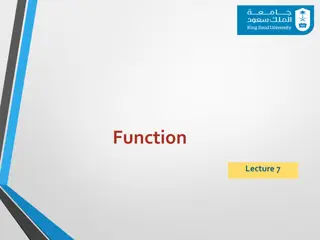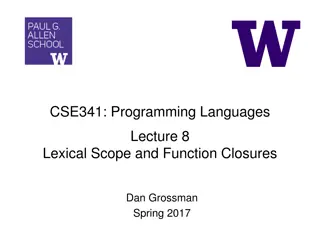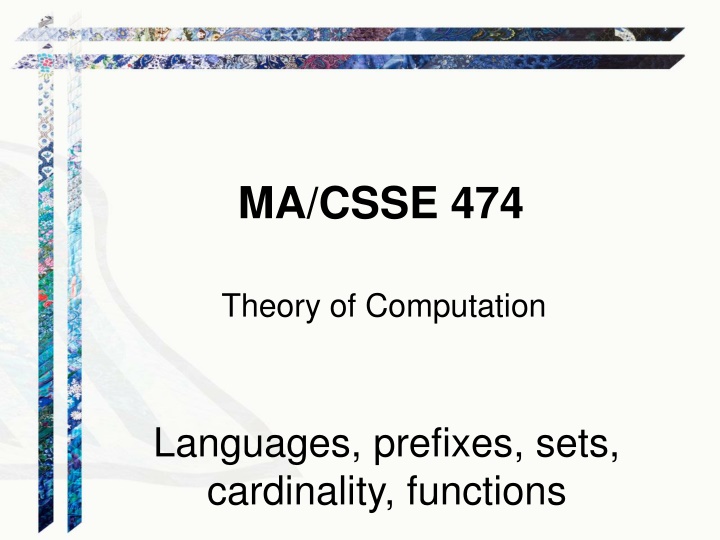
Theory of Computation: Languages, Prefixes, Sets, Cardinality, Functions Overview
Explore the intricate concepts of languages, prefixes, sets, and functions in the theory of computation with discussions on strings, relations, language definitions, natural languages complexities, and the halting problem.
Download Presentation

Please find below an Image/Link to download the presentation.
The content on the website is provided AS IS for your information and personal use only. It may not be sold, licensed, or shared on other websites without obtaining consent from the author. If you encounter any issues during the download, it is possible that the publisher has removed the file from their server.
You are allowed to download the files provided on this website for personal or commercial use, subject to the condition that they are used lawfully. All files are the property of their respective owners.
The content on the website is provided AS IS for your information and personal use only. It may not be sold, licensed, or shared on other websites without obtaining consent from the author.
E N D
Presentation Transcript
MA/CSSE 474 Theory of Computation Languages, prefixes, sets, cardinality, functions
Your Questions? Syllabus Tuesday's discussion Reading Assignments HW1 or HW2 Anything else Must not be a FSM
More about Languages and Strings Mostly very quick. Some should be review of previous courses, and some others you should have gotten for Reading Quiz 2. Ask questions if there are things I list here that you are not sure about.
Relations on Strings: Substring, proper substring Every string is a substring of itself. is a substring of every string. prefix, proper prefix Every string is a prefix of itself. is a prefix of every string. s is a suffix, proper suffix, self,
Defining a Language A language is a (finite or infinite) set of strings over a finite alphabet . Examples for = {a, b} 1. L = {x {a, b}* : all a s precede all b s} , a, aa, aabbb, and bb are in L. aba, ba, and abc are not in L. 2. L = {x : u {a, b}* : x = ua} Simple English description: 3. L = {x#y: x, y {0, 1, 2, 3, 4, 5, 6, 7, 8, 9}* and, when x and y are viewed as the decimal representations of natural numbers, square(x) = y}. Examples (in L or not?): 3#9, 12#144, 3#8, 12, 12#12#12, # 4. L = {an : n 0} uses replication, simpler description of L? 5. AnBn = {akbk : k 0 } 6. L = = { } 7. L = { } You saw in Reading Quiz 2 that the last two examples are different languages
Natural Languages are Tricky L = {w: w is a sentence in English}. Examples: Kerry hit the ball. Colorless green ideas sleep furiously. The window needs fixed. Ball the Stacy hit blue.
A Halting Problem Language L = {w: w is a Java program that, when given any finite input string, is guaranteed to halt}. Is this language well specified? Can we decide which strings L contains?
Languages and Prefixes What are the following languages? L = {w {a, b}*: no prefix of w contains b} L = {w {a, b}*: no prefix of w starts with a} L = {w {a, b}*: every prefix of w starts with a}
Concatenation of Languages If L1 and L2 are languages over : L1L2 = {w * : s L1 ( t L2 (w = st))} Alternate definition: L1L2 = { st : s L1 t L2 } Example: L1 = {a, aa} L2 = {a, c, } Simpler than the first definition, but the first one conveys the idea more precisely. L1L2 =
Concatenation of Languages What is L{ } ? L ? L1L2 LR L3 Is this the same as {w3 : w L } ? L0 Lk L* L+
Formally: Kleene * and + L* = { } {w * : k 1 ( w1, w2, wk L (w = w1w2 wk))} Alternate: L* = L0 L1 L2 . . . = ?=0 ?? L+ = L L* L+ = L* - { } iff L L+ is the closure of L under concatenation.
Concatenation and Reverse of Languages Theorem: (L1L2)R = L2RL1R. Proof: x ( y ((xy)R = yRxR)) Theorem 2.1 that we proved last time (L1L2)R = {(xy)R : x L1 and y L2} = {yRxR : x L1 and y L2} = L2RL1R Definition of concatenation of languages Thm 2.1 Definition of concatenation of languages
Determining Language Membership Computational approaches: Enumerator (generator) When it is asked, enumerator gives us the next element of the language. Any given element of the language will appear within a finite amount of time. Recognizer Given a string s, recognizer halts and accepts s if s is in the language. If not, recognizer either halts and rejects s or keeps running forever. This is a semidecision procedure. If recognizer is guaranteed to halt and (accept or reject), it is a decision procedure. Not every language has an enumerator or a recognizer
Enumeration order Enumeration: Order of elements can be arbitrary; not too helpful More useful: lexicographic order enumeration Shortest first Within a length, dictionary order What is the lexicographic enumeration of: {w {a, b}* : |w| is even} :
Sets of Sets The power set of S is the set of all subsets of S. Let S = {1, 2, 3}. Then: P(S) = { , {1}, {2}, {3}, {1, 2}, {1, 3}, {2, 3}, {1, 2, 3}}. P(S) is a partition of a set S iff: Every element of is nonempty, Every pair of elements of is disjoint , and the union of all the elements of equals S. Some partitions of = {1, 2, 3}: {{1}, {2, 3}} or {{1, 3}, {2}} or {{1, 2, 3}}. How many different partitions of S?
Closure A set S is closed under binary operation op iff x,y S ( x op y S) , closed under unary function f iff x S (f(x) S) b) S' is closed under f c) No proper subset of S' contains S and is closed under f If S is not closed under unary function f, a closure of S is a set S' such that a) S is a subset of S' Examples + (the set of all positive integers) is closed under addition and multiplication but not negation, subtraction, or division. What is the closure of + under subtraction? Under division? The set of all finite sets is closed under union and intersection. Closed under infinite union?
Equivalence Relations A relation on a set A is any set of ordered pairs of elements of A. A relation R A A is an equivalence relation iff it is: reflexive, symmetric, and transitive. Examples of equivalence relations: Show that is an equivalence relation Equality Lives-at-Same-Address-As Same-Length-As Contains the same number of a's as
Cardinality of a Set The cardinality of every set we will consider is one of the following : a specific natural number (if S is finite), or countably infinite (if S has the same number of elements as the natural numbers), or uncountably infinite (if S has more elements than the natural numbers). When we say uncountably infinite, we will actually mean the cardinality of the real numbers , which equals the cardinality of the power set of the natural numbers,
How Large can a Language Be? The smallest language over any is , with cardinality 0. The largest is *. How big is it? Theorem: If then * is countably infinite. Proof: The elements of * can be lexicographically enumerated by the following procedure: Enumerate all strings of length 0, then length 1, then length 2, and so forth. Within the strings of a given length, enumerate them in dictionary order. This enumeration is infinite since there is no longest string in *. Since there exists an infinite enumeration of *, it is countably infinite.
How Many Languages Are There? Theorem: If then the set of languages over is uncountably infinite. Proof: The set of languages defined on is P( *). * is countably infinite. If S is a countably infinite set, P(S) is uncountably infinite*. So P( *) is uncountably infinite. This follows from Cantor's Theorem A nice, accessible write-up of just the amount of set theory you need to know to understand a proof of Cantor's theorem, and countable and uncountable sets: http://legacy.earlham.edu/~peters/writing/infapp.htm Wikipedia article on Cantor's Theorem: http://en.wikipedia.org/wiki/Cantor's_theorem
Functions on Languages Functions whose domains and ranges are languages maxstring(L) = {w L: z * (z wz L)}. Examples: maxstring( AnBn ) Exercise for later: What language is maxstring({bna: n 0}) ? maxstring( {a}* ) Let INF be the set of infinite languages. Let FIN be the set of finite languages. Are the language classes FIN and INF closed under maxstring?
Functions on Languages chop(L) = {w : x L (x = x1cx2, x1 L*, x2 L*, c L, |x1| = |x2|, and w = x1x2)}. What is chop(AnBn)? What is chop(AnBnCn)? Are FIN and INF closed under chop?
Functions on Languages firstchars(L) = {w : y L (y = cx c L x L* w {c}*)}. . What is firstchars(AnBn)? What is firstchars({a, b}*)? Are FIN and INF closed under firstchars?
Decision Problems A decision problem is simply a problem for which the answer is yes or no (True or False). A decision procedure answers a decision problem. Examples: Given an integer n, does n have a pair of consecutive integers as factors? The language recognition problem: Given a language L and a string w, is w in L? Our focus in this course
The Power of Encoding Anything can be encoded as a string. For example, on a computer everything is encoded as a string of bits. <X> is a notation that means "the string encoding of X". <X, Y> means "the string encoding of the pair X, Y". Problems that don t look like decision problems about strings and languages can be recast into new problems that do look like that.
Web Pattern Matching Pattern matching on the web: Problem: Given a search string w and a web document d, do they match ? In other words, should a search engine, on input w, consider returning d? An instance of the problem: (w, d) The language to be decided: {<w, d> : d is a candidate match for the string w}
The Halting Problem Does a given program always halt? Problem: Given a program p, written in some some standard programming language L, is p guaranteed to halt, no matter what input it is given? An instance of the problem: Does Python program "print(input())" always halt? The language to be decided: HPALL = {p L : p halts on all inputs}
Primality Testing Problem: Given a nonnegative integer n, is it prime? An instance of the problem: Is 9 prime? To encode the problem we need a way to encode each instance: We encode each nonnegative integer as a binary string. The language to be decided (2 ways to express it): PRIMES = {w : w is the binary encoding of a prime integer}. Equivalent: PRIMES = {<n> : n is a prime integer}.
Graph Connectivity Problem: Given an undirected graph G, is it connected? Instance of the problem: 1 2 3 4 5 Encoding of the problem: Let V be a set of binary numbers, one for each vertex in G. Then we construct G as follows: Write |V| as a binary number, Write a list of edges, Each pair of binary numbers represents one edge. Separate all such binary numbers by / . 1/10/1/100/10/101/10/11 The language to be decided: CONNECTED = {w {0, 1, /}* : w = n1/n2/ ni, where each ni is a binary string and w encodes a connected graph, as described above}.
Protein Sequence Allignment Problem: Given a protein fragment f and a complete protein molecule p, could f be a fragment from p? Encoding of the problem: Represent each protein molecule or fragment as a sequence of amino acid residues. Assign a letter to each of the 20 possible amino acids. So a protein fragment might be represented as AGHTYWDNR. The language to be decided: {<f, p> : f could be a fragment from p}.
Turning Problems into Decision Problems Casting multiplication as decision: Problem: Given two nonnegative integers, compute their product. Encoding of the problem: Transform computing into verification. The language to be decided: L = {w of the form: <integer1>x<integer2>=<integer3>, where: <integern> is any well formed integer, and integer3 = integer1 integer2} 12x9=108 L 12=12 L 12x8=108 L
Turning Problems Into Decision Problems Casting sorting as decision: Problem: Given a list of integers, sort it. Encoding of the problem: Transform the sorting problem into one of examining a pair of lists. The language to be decided: {w1#w2: n 1 (w1 is of the form <int1, int2, intn>, w2 is of the form <int1, int2, intn>, and w2 contains the same objects as w1 and w2 is sorted)} Examples: <1,5,3,9,6>#<1,3,5,6,9> L <1,5,3,9,6>#<1,2,3,4,5,6,7> L L =
Turning Problems Into Decision Problems Casting database querying as decision: Problem: Given a database and a query, execute the query. Encoding of the problem: Transform the query execution problem into evaluating a reply for correctness. The language to be decided: L = {d#q#a: d is an encoding of a database, q is a string representing a query, and a is the correct result of applying q to d} Example: age=23)# (name, age, phone), (John, 23, 567-1234) (Mary, 24, 234-9876)#(select name (John) L
The Traditional Problems and their Language Formulations are Equivalent By equivalent we mean that either problem can be reduced to the other. If we have a machine to solve one, we can use it to build a machine to do the other, using only the starting machine and other functions that can be built using machines of equal or lesser power. Reduction does not always preserve efficiency!
An Example Consider the multiplication example: INTEGERPROD = {w of the form: <integer1>x<integer2>=<integer3>, where: <integern> is any well formed integer representation, and integer3 = integer1 integer2} Given a multiplication procedure, we can build the language recognition procedure : Given the language recognition procedure, we can build a multiplication procedure :












